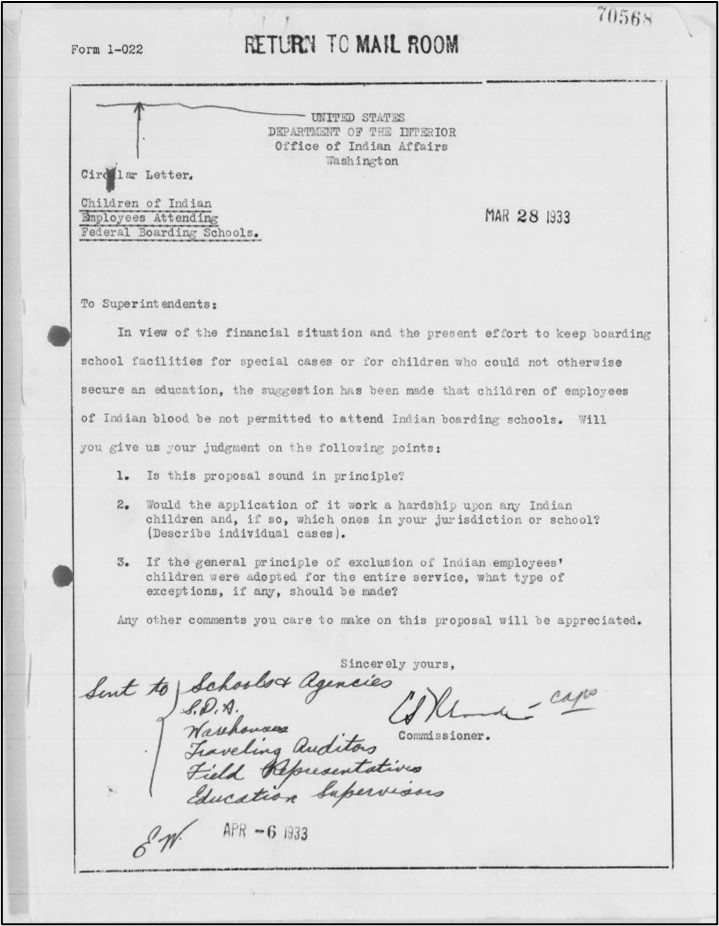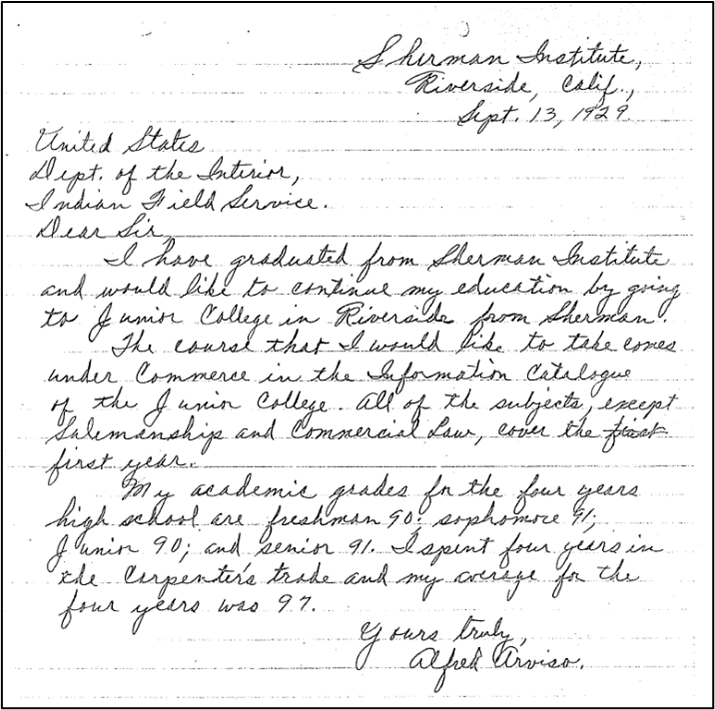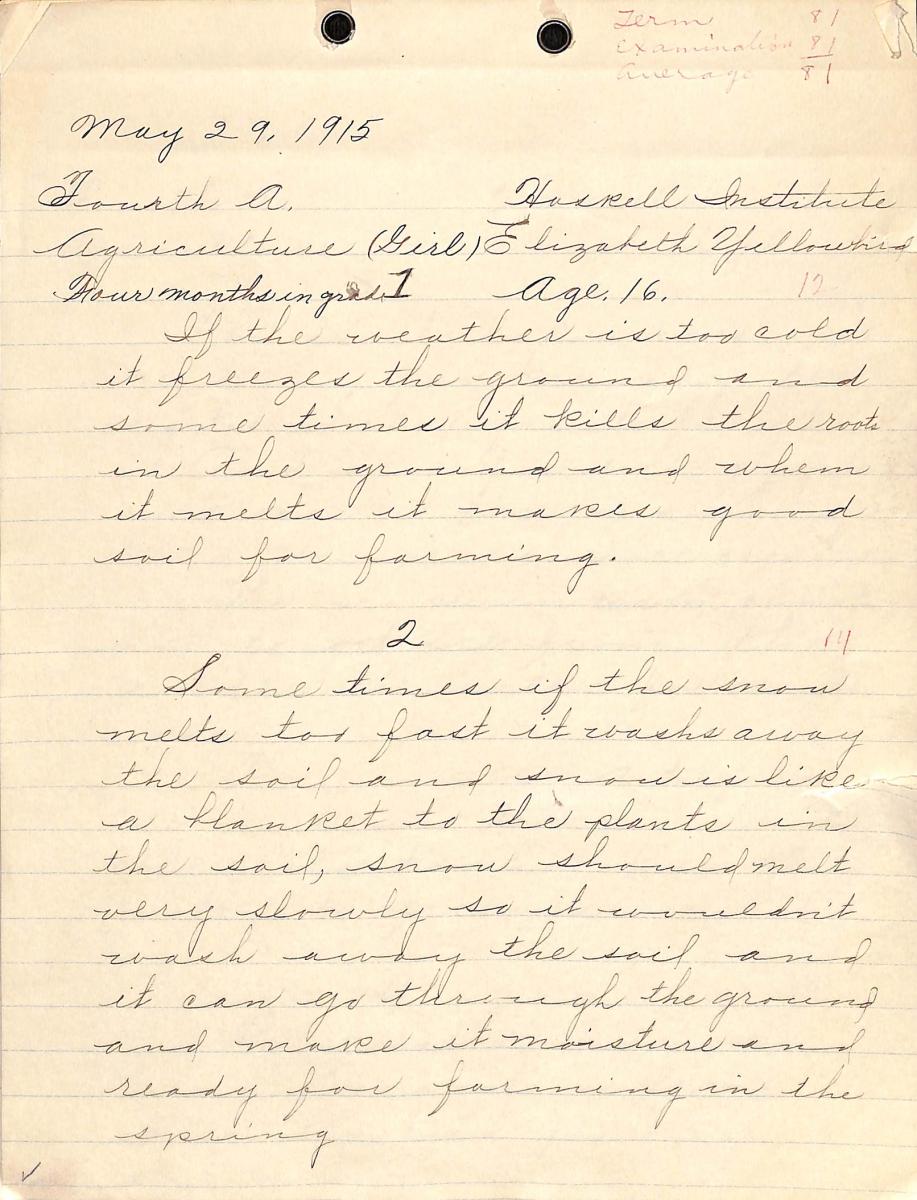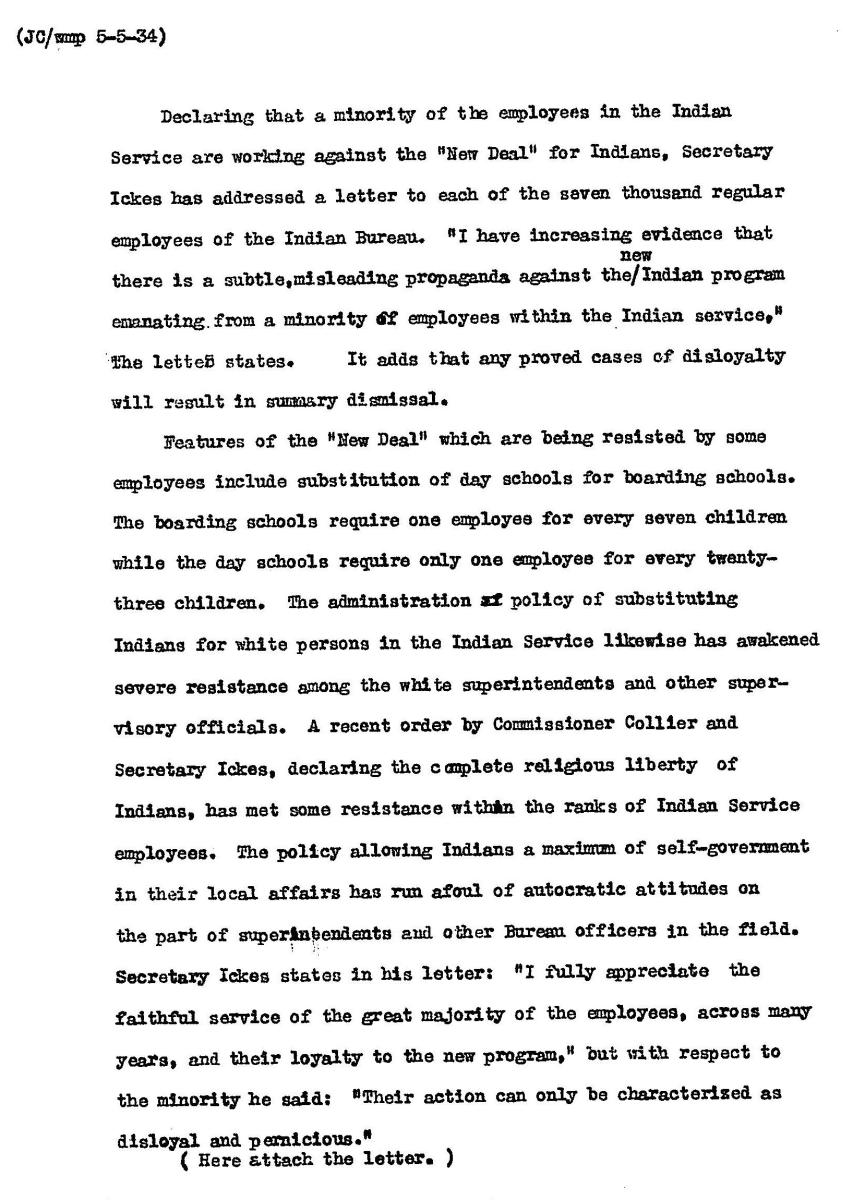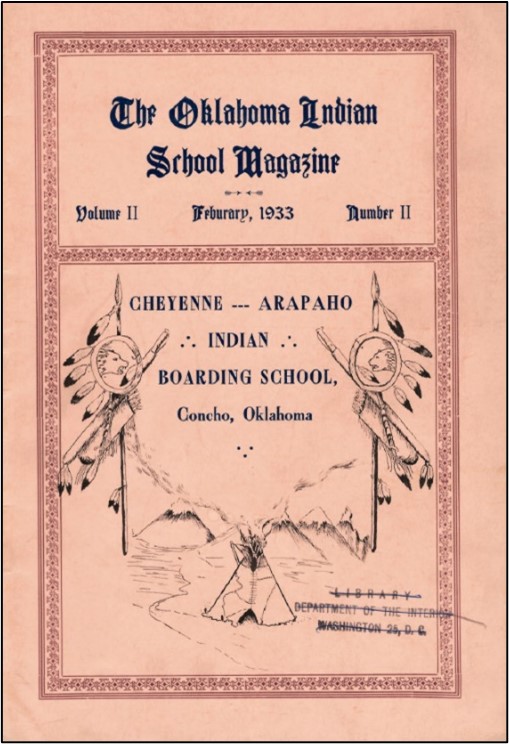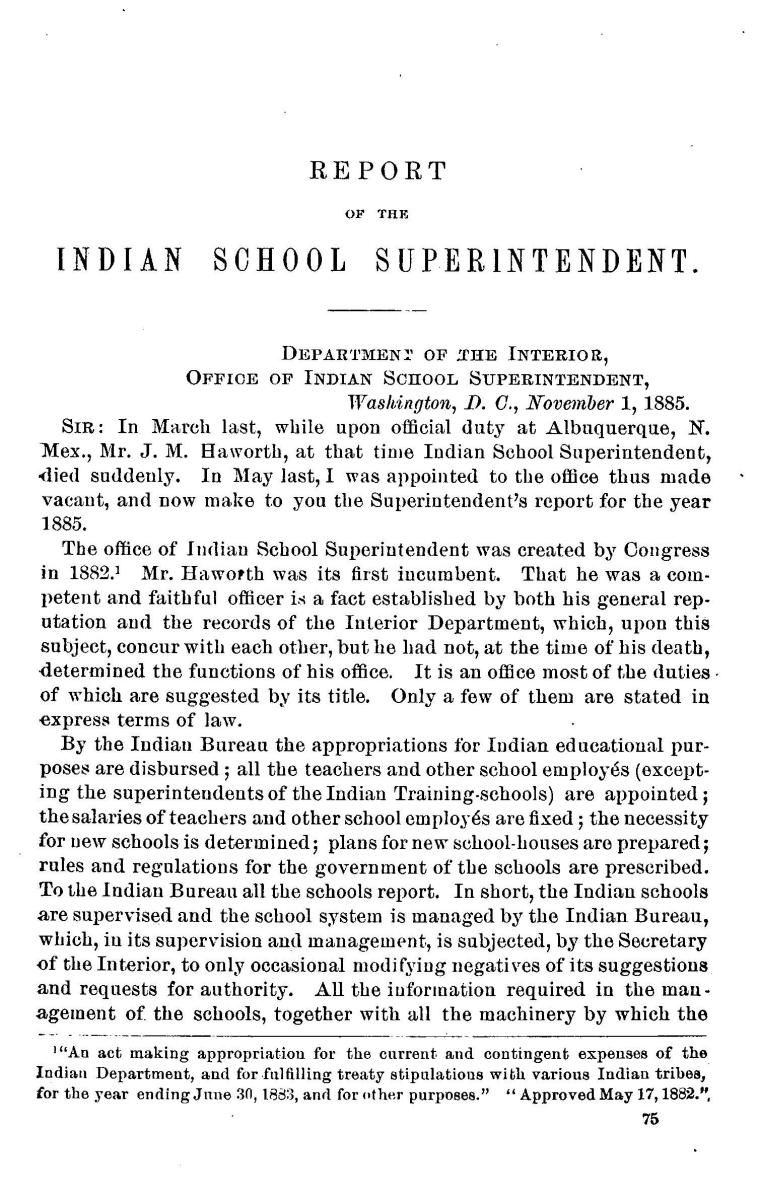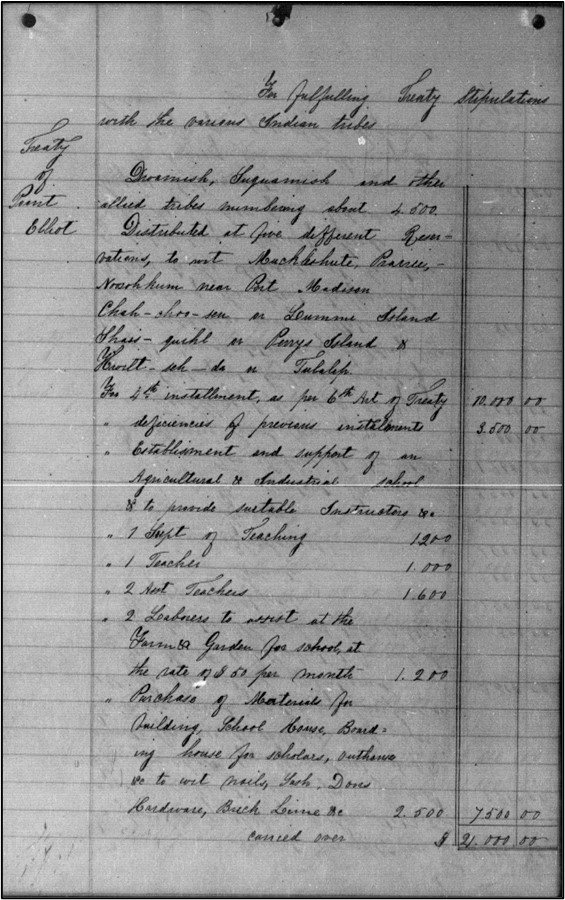
Bureau of Indian Affairs Boarding School Records at the National Archives in Washington, DC
The National Archives and Records Administration (NARA) has many Bureau of Indian Affairs (BIA) records relating to Native American boarding schools. These records are in Record Group 75 and are located at NARA research facilities across the country. Please see BIA Schools for a partial list.
The National Archives in Washington, DC (Archives 1), houses headquarters-level records of the BIA. In general, these records provide a high-level overview of the BIA’s involvement in creating, maintaining, and supporting Native American boarding schools.
Examples are listed below by record type. Select the National Archives Identifiers for the full archival records descriptions in the National Archives Catalog. For questions related to these records, please email the Archives 1 Reference Branch at archives1reference@nara.gov.
Census Records
NARA does not have a consolidated list of all students who attended Native American boarding schools over time. However, Archives 1 has select census records that document Native American students who attended boarding schools in particular years. These records are most useful for identifying students by name and school, and often by tribal affiliation as well.
Below are the main series of BIA census records at Archives 1 related to Native American boarding schools. Please note that additional censuses can be interfiled in BIA correspondence series (see Correspondence below).
- “Census Roll and List of Allotments of Ottawa Indians of Kansas, 1863–1864” (National Archives Identifier: 2124184)
- “Indian Census Rolls, 1885–1941” (National Archives Identifier: 595276)
- These records are digitized. See How Can I Access the Indian Census Rolls? for links.
- “Census Records of Southern Utes of School Age at Southern Ute Agency and of Mescalero and White Mountain Apaches, 1892–1892” (National Archives Identifier: 1311457)
- “Revised Roll of Sisseton-Wahpeton Sioux in South Dakota, 1903–1903” (National Archives Identifier: 1275592)
- “Annual School Census Reports, 1912–1939” (National Archives Identifier: 1812864)
-
“Miscellaneous Population and Education Census Rolls, ca. 1955–ca. 1960” (National Archives Identifier: 300318)
Circulars and Replies
Circulars are generally one- to three-page letters from high-level administrators at the BIA to the agency’s field officials. Most established or clarified policies and procedures that field officials were expected to follow. However, circulars also solicited information from field officials for use in administrative reports, policy assessment, or other purposes.
Archives 1 has several series of BIA circulars, most dating to the early to mid-twentieth century. (Circulars issued prior to 1854 were usually copied into letter books of outgoing correspondence; see Correspondence below for specific series.) These records can be useful for understanding the BIA’s overall approach to administering federal boarding schools for Native Americans, including the students who were eligible to attend and the general content of school curricula.
But circulars can also hint at potentially useful records in other series, such as correspondence. For example, a 1933 BIA circular to agency superintendents (see right) asked for feedback on a proposed policy to prohibit Native American employees’ children from attending boarding schools. The circular specifically asked for information about individual children whom the policy might negatively affect. Thus, replies to this circular (if extant) might include names of Native children who were attending boarding schools at the time the circular was issued.
For related series, please see Correspondence and Superintendency Records below.
- “Orders and Circulars, 1854–1955” (National Archives Identifier: 1116812)
- This series is digitized in the National Archives Catalog.
- “Circulars, Orders, and Other Issuances, 1876–1962” (National Archives Identifier: 1117176)
- “Circulars Issued [by the Education Division], 1897–1909” (National Archives Identifier: 1766502)
- “Circulars Issued by the Superintendent of Indian Schools, 1899–1908” (National Archives Identifier: 1766512)
- “Replies to Circulars, 1907–1935” (National Archives Identifier: 2123828)
-
“Records Concerning a School Survey, 1922–1922” (National Archives Identifier: 2194544)
Correspondence
Correspondence represents the bulk of the BIA headquarters-level records at Archives 1. BIA administrators communicated frequently with field officials, tribes, other federal agencies, private organizations, religious groups, and members of Congress and the public. Whereas reports and statistics provide a high-level overview of BIA activities, and circulars and replies focus on a specific policy or procedure, correspondence offers a more granular level of detail about the BIA’s interactions with Native American tribes and individuals.
This does not mean that all individuals who attended Native American boarding schools are documented by name in BIA headquarters-level correspondence; BIA field officials, such as teachers and superintendents, interacted locally with students and did not always need to consult agency administrators about day-to-day activities. But when they did, or when students or their family members wrote to BIA administrators directly, headquarters-level correspondence can include important details about students’ experiences at boarding schools.
Bureau of Indian Affairs Records: Correspondence Files discusses most BIA headquarters-level correspondence for the time period 1800–1880.
Bureau of Indian Affairs Central Classified Files, 1907–1975 discusses most BIA headquarters-level correspondence for the time period 1907–1975.
In addition to the records described on those pages, the following series of BIA headquarters-level correspondence also contain information about Native American boarding schools:
- “Oversized Records, ca. 1859–1934” (National Archives Identifier: 2123822)
- “Letters Received, 1881–1907” (National Archives Identifier: 300337)
- See the blog post “Accessing the Letters Received by the Office of Indian Affairs, 1881–1907” for more information about these records.
- “Press Copies of Letters Sent, 1870–1908” (National Archives Identifier: 2106334)
- “Letters Concerning Schools Sent by the Secretary of the Interior to Officials in Indian Territory, 1898–1906” (National Archives Identifier: 1311439)
- “Briefs of Investigations, 1899–1911” (National Archives Identifier: 1768123)
- “Abstracts of Letters Relating to Epidemics, 1901–1908” (National Archives Identifier: 1768153)
- “Correspondence Concerning Estelle Reel, Superintendent of Indian Schools, 1902–1902” (National Archives Identifier: 608187)
- “Records Concerning Former Students, 1910–1925” (National Archives Identifier: 1898519)
- “General Correspondence [of the Board of Indian Commissioners], 1919–1933” (National Archives Identifier: 2194537)
- “Correspondence Concerning Field Personnel, 1930–1939” (National Archives Identifier: 2071527)
- “Correspondence [of the Branch of Property and Supply], 1936–1936 (National Archives Identifier: 2192524)
- “Records Relating to the Catawba Tribe, 1940–1962” (National Archives Identifier: 2193212)
Alaska Division Correspondence
Archives 1 also has correspondence from the Alaska Division, which was originally part of the Department of the Interior’s Office of Education. For more information about the Alaska Division, please see its organization authority record in the National Archives Catalog.
Most Alaska Division correspondence is digitized. For additional BIA records relating to Alaska, see Alaska Digitization Project.
- “Letters Received, 1883–1907” (National Archives Identifier: 1900095)
- This series is digitized in the National Archives Catalog.
- “Letters Sent, 1887–1908” (National Archives Identifier: 1900021)
- This series is digitized in the National Archives Catalog.
- “Correspondence and Reports, 1896–1901” (National Archives Identifier: 1900029)
- “Correspondence Concerning the Metlakatla Controversy, 1897–1931” (National Archives Identifier: 1910383)
- This series is digitized in the National Archives Catalog.
- “Press Copies of Letters Sent, 1898–1903” (National Archives Identifier: 1900060)
- “Letters Sent to the Secretary of the Interior, 1907–1908” (National Archives Identifier: 1900025)
- This series is digitized in the National Archives Catalog.
- “Indexes to General Correspondence, 1910–1930” (National Archives Identifier: 1900109)
- This series is digitized in the National Archives Catalog.
- “General Correspondence, 1908–1935” (National Archives Identifier: 1910381)
- This series is digitized in the National Archives Catalog.
-
“Copies of Letters and Telegrams Sent, 1935–1937” (National Archives Identifier: 1900078)
Financial Records
BIA annual reports often indicate the total amount the agency spent on education for Natives in a given fiscal year (see Reports below). However, BIA financial records at Archives 1 can provide more precise information about appropriations and expenditures for specific boarding schools, both federal and private.
On a broad level, these records provide concrete evidence of the federal government’s investment in and support for Native American boarding schools. More specifically, these records can be helpful for developing a comprehensive list of Native American boarding schools and the years they operated.
Most BIA appropriation ledgers and expenditure statements at Archives 1 are arranged chronologically. For years that fall outside of the series listed below, consult the relevant BIA correspondence series (see Correspondence above).
Additional financial records can be found among BIA superintendency records (see Superintendency Records below) and statistical records (see Statistics below).
- “Appropriation Ledgers, 1837–1921” (National Archives Identifier: 1931917)
- “Contracts and Bonds for Goods and Services, 1875–1911” (National Archives Identifier: 1943627)
- Note: Volumes 124–139 contain contracts made with religious and other organizations operating boarding, day, and public schools.
- “Registers of Contracts, 1878–1926” (National Archives Identifier: 1943617)
- “Records of School Contracts, 1887–1911” (National Archives Identifier: 1807678)
- “Statements of Accounts of Disbursing Officers, 1900–1908” (National Archives Identifier: 1938515)
- “Accounting Ledgers Showing Appropriations, Authorizations, and Expenditures, 1907–1922” (National Archives Identifier: 1910396)
- “Appropriation Ledgers for Expenditures for Field Work, 1917–1924” (National Archives Identifier: 1936783)
- “Statements of Expenditures by Agencies and Schools, 1917–1931” ( National Archives Identifier: 1488328)
- “Annual Statements of Expenditures by States, 1920–1925” (National Archives Identifier: 1936988)
- “Various Land and Finance Records, 1920–1950” (National Archives Identifier: 4706984)
-
“Student Records Relating Principally to Loan Applications, 1948–1949” (National Archives Identifier: 1311972)
General Records
The series described in this section do not fall easily into other record categories. Some of the series are broad and include many different types of records (e.g., correspondence, memoranda, and reports). Others are narrow and include very specific types of records (e.g., examination papers).
As with the correspondence series described above (see Correspondence), boarding school information in these series is often dispersed and only identified after an in-depth examination of the records. However, all series listed here include some degree of information about Native American boarding schools or the students who attended them.
For example, the examination paper to the right was written by Elizabeth Yellowbird, a sixteen-year-old girl enrolled in an agriculture class at Haskell Institute in 1915. In her paper, Elizabeth describes the impact of cold weather and snowfall on soil conditions.
- “Reports, Lists, Statements, and Other Records, 1836–1887” (National Archives Identifier: 2107204)
- “Reference Materials, ca. 1875–1933” (National Archives Identifier: 2194551)
- “Reference Books Concerning Schools, 1882–1909” (National Archives Identifier: 1768108)
- “Examination Papers, 1888–1915” (National Archives Identifier: 1848101)
- “General Records Relating to Education, 1889–1972” (National Archives Identifier: 1318720)
- “Summary Descriptions of Indian Agencies and Schools, 1904–1906” (National Archives Identifier: 1985469)
- “Memoranda and Other Records, 1905–1915” (National Archives Identifier: 1766460)
- “Records Concerning Indians, Indian Culture, and Activities of the Bureau of Indian Affairs, ca. 1906–1965” (National Archives Identifier: 2122519)
- “Subject Files, 1910–1969” National Archives Identifier: 1328704)
- “General Subject Files, 1929–1968” (National Archives Identifier: 1353866)
- “School Calendars, 1930–1934” (National Archives Identifier: 1853252)
- “Records Relating to a Social and Economic Survey, 1933–1934” (National Archives Identifier: 1968618)
- “General Records, 1933–1944” (National Archives Identifier: 2103102)
- “Reports and Other Records [of the Statistics Division], 1933–1948” (National Archives Identifier: 2050767)
- “Records Relating to Summer Education Programs, 1951–1969” (National Archives Identifier: 1323195)
- “Records Relating to Agencies Transferred from Area Office to Central Office Jurisdiction, 1955–1960” (National Archives Identifier: 647883)
-
“Records Relating of the Office of Economic Opportunity Programs, 1964–1968” (National Archives Identifier: 2192561)
Office Files of BIA Officials
Archives 1 has several series of office files maintained by BIA commissioners and other high-level administrators during their tenure. These files can include correspondence, reports, and secondary sources about Native American boarding schools. Such records can shed light on administrators’ thought processes while developing and implementing agency policy about boarding schools, as well as suggest the internal and external resources they consulted to inform their decisions.
For example, the document to the right is a proposed press release about the Interior Department’s response to alleged resistance from employees to parts of the Indian New Deal, including a shift from boarding schools to day schools. The document is part of a file on publicity maintained by Commissioner John Collier (National Archives Identifier: 5677315). Secretary of the Interior Harold L. Ickes ultimately did not approve the press release, citing it as “dangerous.”
Additional records created and received by BIA administrators can be found in BIA correspondence series (see Correspondence above).
- “Reference Files of William Hamilton, 1888–1926” (National Archives Identifier: 1914968)
- William Hamilton was the Assistant Chief of the Alaska Division, which coordinated federal education for Alaska Natives.
- “Office Files of Hervey B. Peairs, 1910–1927” (National Archives Identifier: 1766866)
- Hervey B. Peairs was the BIA’s Superintendent of Indian Education from 1910 to 1917 and from 1921 to 1926, as well as the BIA’s General Superintendent of Indian Education (later, Director of Indian Education) from 1926 to 1930. For the period 1921 to 1926, he was also Superintendent of Haskell Institute.
- “Reference Files of Carrie A. Lyford, ca. 1921–1932” (National Archives Identifier: 1862069)
- Carrie A. Lyford was a Demonstration Teacher of Home Economics and later an Associate Supervisor of Home Economics for the BIA.
- “Office Files of Carrie A. Lyford, 1929–1932” (National Archives Identifier: 1861997)
- “Office Files of Mary Stewart, 1929–1936” (National Archives Identifier: 1768076)
- Mary Stewart was the BIA’s Assistant Director of Education from 1929 to 1936. She later became the BIA’s Superintendent of Indian Education.
- “Office Files of W. Carson Ryan, 1931–1935” (National Archives Identifier: 1768047)
- W. Carson Ryan was the BIA’s Director of Education during the early 1930s.
- “Office Files of Commissioner John Collier, 1933–1945” (National Archives Identifier: 611812)
- This series is available online through ProQuest’s American Indians and the American West database, which is accessible for free on-site at NARA research facilities.
- “Office Files of John Herrick, Assistant to the Commissioner, 1936–1941” (National Archives Identifier: 644739)
- “Records of Advisor Ward Shepard, 1936–1948” (National Archives Identifier: 644996)
- “Office Files of Associate Commissioner James E. Officer, 1959–1967” (National Archives Identifier: 649588)
- “Correspondence Files of Commissioner Philleo Nash, 1961–1966” (National Archives Identifier: 648006)
- “Office Files of Commissioner Philleo Nash, 1961–1966” (National Archives Identifier: 648009)
- “Office Files of Commissioner Robert L. Bennett, 1966–1969” (National Archives Identifier: 300303)
- “Subject Files of Commissioner Louis R. Bruce, 1969–1972” (National Archives Identifier: 300306)
- “Office Files of Commissioner Louis R. Bruce, 1969–1972” (National Archives Identifier: 300305)
-
“Commissioner Morris Thompson's Files, 1974–1976” (National Archives Identifier: 612097)
Publications
NARA generally does not collect government publications. In most instances, published materials are considered to be “non-record” material and are not included among our record holdings. For more information, please see Government Publications and Library Materials.
However, the BIA, like other federal agencies, maintained record copies of select laws, regulations, pamphlets, and other government publications, which became part of the permanent BIA records at Archives 1. These publications include select Indian School Service regulations and manuals, which provide information about boarding school policy.
Records also include copies of select student-produced newspapers and magazines, such as The Oklahoma Indian School Magazine pictured at right, which was produced by students at the Cheyenne-Arapaho Boarding School (also known as the Concho Boarding School) in 1933 (see National Archives Identifier: 1317883). Student publications can illuminate student life at boarding schools and provide names, tribal affiliations, and sometimes photographs of select students.
Additional copies of government regulations and manuals can be interfiled within BIA correspondence series (see Correspondence above). Additional copies of student-produced media can be found in BIA field office records at other NARA research facilities. See Navigating Record Group 75: BIA Schools for a select list of federal boarding schools and the NARA facilities that have their records.
- “Publications Relating to Indian Schools, 1885–1952” (National Archives Identifier: 1317883)
- “Publications Files, 1907–1950” (National Archives Identifier: 2103047)
-
“Regulations of the United States Indian Field Service, 1929–1957” (National Archives Identifier: 1128456)
Reports
The BIA, like other federal agencies, annually reports on its activities and expenditures to its Cabinet-level Department (the War Department from 1824 to 1849, and the Department of the Interior since 1849), and through that Department, to Congress. These reports have taken different forms over the years, but they usually compile narrative and statistical information from across the agency’s field offices to demonstrate the agency’s fulfillment of its mission.
As education has been an important component of the federal government’s policies for assimilating Native Americans, most annual reports include information about educational activities for Natives—including information about the establishment and maintenance of Native boarding schools (federal and private) and statistics representing student enrollment and deaths at these schools.
For example, beginning in 1880, the annual reports include specific reports from boarding schools like Carlisle. From 1885 to 1906, the annual reports also include a special report from the Indian School Superintendent, a position authorized by Congress in 1882 to inspect schools for Natives, ensure that treaty stipulations related to education were carried out, and implement a plan for educating all Native youth. After 1906, the annual reports tend to focus on overall BIA policies and programs and less on specific activities at individual agencies and schools.
The BIA’s annual reports are published and available online through multiple sources. Copies of some annual reports are interfiled within BIA correspondence series (see Correspondence above) and BIA superintendency records (see Superintendency Records below).
Archives 1 also houses primary source material that the BIA used to compile its annual reports. These records include narrative and statistical reports from superintendents, inspection reports, medical reports, school reports, and other reports specific to a BIA agency or jurisdiction, most of which are from the 20th century. These reports can provide useful detail about specific agencies and schools that is often absent in 20th-century annual reports. For additional information, please see Statistics below.
Alaska Division Reports
- “Annual School Reports, 1933–1937” (National Archives Identifier: 1910436)
- This series is digitized in the National Archives Catalog.
- “Quarterly School Reports, 1937–1940” (National Archives Identifier: 1913650)
- This series is digitized in the National Archives Catalog.
Annual Reports
- Annual Reports of the Commissioner of Indian Affairs (Government Publishing Office)
- Annual reports from approximately 1826 through 1932 have been digitized and made available online for free through the University of Wisconsin Libraries’ website.
- More recent reports are typically subsumed within the annual reports of the Secretary of the Interior, many of which are available online for free through the Hathi Trust Digital Library. Additional copies may be found at Federal Depository Libraries.
- “Superintendents' Annual Narrative and Statistical Reports, 1910–1935” (National Archives Identifier: 2049908)
- This series is digitized in the National Archives Catalog.
Inspection Reports
- “Inspection Reports, 1908–1940” (National Archives Identifier: 2034460)
Medical Reports
- “Hospital Reports, 1923–1938” (National Archives Identifier: 1948926)
- “Physicians’ Annual and Semiannual Reports, 1925–1930” (National Archives Identifier: 1945699)
- “Reports of Field Nurses, 1931–1943” (National Archives Identifier: 1956117)
- “Reports of School Social Workers, 1932–1936” (National Archives Identifier: 1862077)
- “Case Records Concerning the Traveling Mental Health Clinic, 1935–1935” (National Archives Identifier: 1871958)
School Reports
- “Statistical School Reports, 1901–1936” (National Archives Identifier: 1842596)
- “Quarterly School Reports, 1910–1939” (National Archives Identifier: 1822378)
- “Annual School Reports, 1924–1937” (National Archives Identifier: 1823641)
- “Semiannual School Reports, 1925–1937” (National Archives Identifier: 1823454)
Miscellaneous Reports
- “School Reports [Mackinac Agency], 1855–1882” (National Archives Identifier: 2125484)
- “Monthly School Reports for the Tulalip Agency in Washington, 1874–1911” (National Archives Identifier: 1812920)
- “Quarterly School Reports for the Puyallup and Tulalip Agencies in Washington, 1886–1910” (National Archives Identifier: 1812924)
- “Summaries of Work Completed and Records Relating to Mission Schools, 1887–1891” (National Archives Identifier: 1766413)
- “Records of Schools, 1895–1895” (National Archives Identifier: 1801234)
- “Reports of the Commissioner to the Five Civilized Tribes, 1908–1913” (National Archives Identifier: 1253346)
- “Reports Concerning Graduates of Indian Schools, 1914–1916” (National Archives Identifier: 1898510)
- “Reports and Related Records, 1943–1967” (National Archives Identifier: 2194794)
-
“Progress Reports, 1962–1974” (National Archives Identifier: 1353910)
School Land and Building Records
Archives 1 has select BIA records documenting boarding school buildings and the land set aside for them. These records can be useful for pinpointing where boarding schools were located.
Additional records related to BIA buildings and land can be found in BIA correspondence series (see Correspondence above). NARA’s Cartographic Branch also has relevant BIA maps.
Other records might be found in Record Group 49, Records of the Bureau of Land Management (BLM). Archives 1 has headquarters-level records of the BLM.
- “Allotment Schedules, 1856–1935” (National Archives Identifier: 1991064)
- “Abstracts of Official Reports Concerning School Plants, 1898–1905” (National Archives Identifier: 1801244)
- “Abstract of Title to Property in Riverside, California, 1900–1900” (National Archives Identifier: 2060333)
- “Contract Papers Concerning Construction of Federal Buildings in Alaska, 1930–1932” (National Archives Identifier: 1910398)
-
“Files for Public Works Administration Projects, 1931–1943” (National Archives Identifier: 2103083)
Statistics
BIA officials maintained statistical records about Native American education to assist with decision-making and reporting requirements. Sometimes, these statistics were drawn from reports that are also housed at Archives 1 (see Reports above). At other times, the original reports were not retained, and only the statistics now remain. Regardless, these series can be useful for tracking enrollment, attendance, and expenditures at federal boarding schools over time. Some series also document private boarding schools, reservation day schools, and public schools.
For related records, see Correspondence, Financial Records, and Reports above.
- “Data Book for the Civilization Fund, ca. 1824–1832” (National Archives Identifier: 2107207)
- “Statistics Relating to Education, 1859–1869” (National Archives Identifier: 1768184)
- “Roster of Schools from New York to Makah, 1862–1864” (National Archives Identifier: 1311442)
- “Rosters and Statistics Relating to Indian Schools, 1874–1884” (National Archives Identifier: 1768536)
- “Statistics from Monthly Sanitary Reports, 1880–1881” (National Archives Identifier: 1848617)
- “Statistics Relating to Indian Schools, 1882–1909” (National Archives Identifier: 1771561)
- “Copies of Statistics Relating to Schools, 1890–1908” (National Archives Identifier: 1771963)
- “Statistics from Semimonthly School Reports, 1893–1895” (National Archives Identifier: 1772599)
- “Enrollment and Attendance Statistics from Monthly School Reports, January 1895–October 1895” (National Archives Identifier: 1781381)
- “Statistics from Monthly School Reports, July 1895–June 1896” (National Archives Identifier: 1781399)
- “Statistics from Monthly School Reports, 1904–1910” (National Archives Identifier: 1799571)
- “Educational Survey Forms, 1929–1932” (National Archives Identifier: 1862074)
- “Monthly Statistical Reports, 1941–1968” (National Archives Identifier: 1353844)
Alaska Division Statistics
- “Statistical Charts on the Operation of Native Schools, 1925–1928” (National Archives Identifier: 1910434)
- This series is digitized in the National Archives Catalog.
- “Graph and Statistical Tables on School and Medical Services, 1922–1923” (National Archives Identifier: 1910435)
-
This series is digitized in the National Archives Catalog.
-
Superintendency Records
BIA superintendency records at Archives 1 can often provide more granular information about agency activities—including educational activities and school administration—than headquarters-level records. They can be particularly useful for tracing early efforts at establishing federal boarding schools in certain areas.
For example, the document to the right, which dates to 1862, lists an estimate of appropriations necessary to establish an agricultural and industrial school for tribes in the Puget Sound area, as promised in Article 14 of the Treaty of Point Elliott. The document estimates the cost of building a “school house” and “boarding house for scholars,” among other school buildings, at $2,500.00.
Available records, however, vary widely by superintendency. For some superintendencies, Archives 1 has correspondence (letters sent and received), ledgers, accounts, and other records. For other superintendencies, Archives 1 does not have separate series of records. To find records of these superintendencies, consult BIA headquarters-level correspondence and annual reports of the Commissioner of Indian Affairs. (See Correspondence and Reports above for more information.)
For more information about BIA superintendencies, see the blog post “Office of Indian Affairs Superintendency Records, 1819–1878.”
Microfilmed Records
See BIA Superintendency Records for a list of microfilmed records and their online availability.
Original Records
Michigan Superintendency
- “Letters Received, 1849–1882” (National Archives Identifier: 2125480)
Oregon Superintendency
- “Correspondence, Financial Records, Reports, and Other Records, ca. 1852–1878” (National Archives Identifier: 2133087)
Washington Superintendency
-
“Letters Received, Reports, Accounts, and Other Records, 1864–1873” (National Archives Identifier: 2133208)
Carlisle Indian Industrial School
Archives 1 has surviving historical records created and maintained by the Carlisle Indian Industrial School, which operated from 1879 to 1918. These records are incomplete. However, they include student files and registers, which can provide a student’s name, age, tribal affiliation, and inclusive dates of attendance/enrollment. These records can also indicate if a student died at school and the cause of death.
Photographs of students and information about their activities after leaving Carlisle are sometimes included. For example, Jim Thorpe’s student file includes photographs and newspaper clippings about his success at the 1912 Olympic Games in Stockholm (see National Archives Identifier: 595333).
Additional records relating to Carlisle can be found in BIA correspondence series (see Correspondence above).
Note: Dickinson College’s Carlisle Indian School Digital Resource Center has digitized most Carlisle records at Archives 1.
- “Index to Letters Received, ca. 1905–ca. 1905” (National Archives Identifier: 2133196)
- “Letters Sent, August 28, 1900–May 6, 1901” (National Archives Identifier: 2133218)
- “Registers of Pupils, 1890–1906” (National Archives Identifier: 2133232)
- “Consecutive Record of Pupils Enrolled, 1905–1918” (National Archives Identifier: 2133241)
- “Indexes to Student Records, 1879–1918” (National Archives Identifier: 2133294)
- This series is digitized in the National Archives Catalog.
- “Student Records, 1879–1918” (National Archives Identifier: 300327)
- “Reports on Examinations and Promotions of Pupils, 1917–1918” (National Archives Identifier: 2143330)
- “Student Record Cards, 1879–1918” (National Archives Identifier: 2143365)
- This series is digitized in the National Archives Catalog.
- “Student Information Cards, 1879–1918” (National Archives Identifier: 2143374)
- “Enrollment Cards, ca. 1897–1913” (National Archives Identifier: 2144814)
- “Attendance Books, 1884–1891” (National Archives Identifier: 2153423)
- “Enrollment Status Book, 1898–1902” (National Archives Identifier: 2153430)
- “Records Concerning Former Students, ca. 1898–ca. 1898” (National Archives Identifier: 2162249)
- “Register of Applications for Student Workers, 1885–1890” (National Archives Identifier: 2163480)
- “Registers of Outings, 1881–1918” (National Archives Identifier: 2163492)
- “Ledgers for Student Savings Accounts, 1890–1918” (National Archives Identifier: 2163513)
- “Journal for Payments to Boys, 1908–1912” (National Archives Identifier: 2163516)
- “Journal for the YWCA (Young Women's Christian Association) Account, 1910–1914” (National Archives Identifier: 2163552)
- “Minutes of the Invincible Debating Society, 1894–1918” (National Archives Identifier: 2163586)
- “Register of Visitors, 1909–1917” (National Archives Identifier: 2163601)
- “Published Newspapers, 1898–1903” (National Archives Identifier: 2173220)
- “Correspondence Files Concerning the Carlisle Indian Industrial School, ca. 1916–1966” (National Archives Identifier: 2173228)
-
“Publications and Records Relating to Indian Schools, ca. 1890–ca. 1939” (National Archives Identifier: 2173240)
